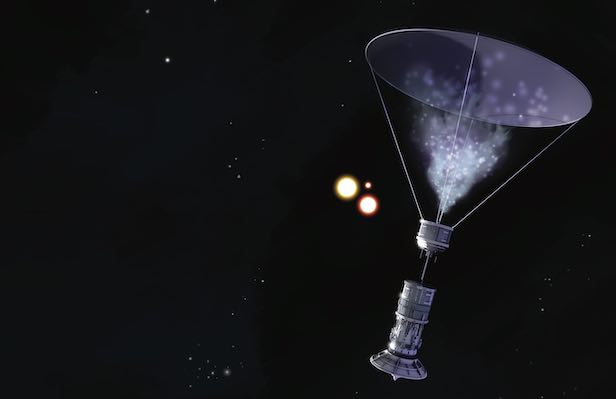Future Tech: Antimatter sailing ships
Our first interstellar probes might sail to the stars on antimatter winds

Ejected from their force field containment, antimatter particles would be sprayed towards the rigid sail, made out of carbon fibre and then coated on the inside with uranium as fission fuel for the propulsion system. Image credit: All About Space/Adrian Mann
The major limitation on space travel is energy. Spectacular rocket launches demonstrate how much energy is needed just to make the first step into space. To travel elsewhere in the Solar System takes even more; with present propulsion technology spacecraft coast around the planets on long minimum energy trajectories. For human spaceflight this means months or years of travel in cramped conditions, exposed to microgravity and cosmic radiation. If we had a way of storing more energy we could build something approaching the large, fast, comfortable spacecraft of science fiction. Interstellar travel will require even more energy and the most compact form of energy we know of is antimatter. Probably best known from its fictional use as the energy source of the Enterprise in Star Trek, but antimatter is a real substance.
Matter is composed of subatomic particles such as neutrally charged neutrons, positively charged protons and negatively charged electrons. Antimatter is the same stuff, but the charges are opposite and its tremendous potential arises because, when it encounters matter, both are annihilated and converted from matter into energy. Matter is equal to energy in the proportion of Einstein’s famous equation E=mc2, where E is energy, m is matter and c2 is the speed of light squared. The velocity of light is 300 million metres (186,000 miles) per second and an enormous amount of energy is stored in matter, about a thousand times more than in nuclear fuel and a billion times more than hydrocarbons – an organic compound that consists entirely of hydrogen and carbon atoms.
The challenge is how such a prodigious resource can be used, one you can’t actually hold in anything solid. However, Gerald Jackson and Steven Howe of Hbar Technologies have an idea for both of those challenges. From an idea first proposed at a Particle Accelerator Conference in America, they have designed a sailing spaceship powered by puffs of anti-hydrogen. Anti-hydrogen is the simplest neutral antimatter possible, composed of one antiproton and one positron; Hbar propose to store their anti-hydrogen as tiny snowflakes suspended in electric fields. If this sounds difficult to scale, the ship would only need 17 grams of fuel to reach interstellar space over ten years. Yet, at the same time, the world record for storing anti-hydrogen is 38 individual atoms.
To safely release the energy from the antimatter, Hbar propose to eject a spray of anti-hydrogen from the front of the spaceship fuselage, blowing it at a concave, disc shaped sail stretched out ahead of the ship. This is no flexible, lightweight polyester like other space sails though; Hbar’s sail would be a rigid carbon fibre dish, coated on the interior with uranium! Uranium is the most commonly used nuclear fission fuel, a natural occurring element heavier than lead. When the anti-hydrogen spray hits the sail the matter-antimatter reactions would induce nuclear fission (atom splitting) in the uranium; and it is this reaction that would produce a stream of heavy, high energy particles zipping away and pushing the sail.
Hbar have designed a space probe based upon their concept, equipped with a five metre diameter sail, which they estimate could reach 10 per cent of the speed of light after a year of acceleration; this would reach Alpha Centauri in only 42 years and probably has less engineering hurdles than any other near term interstellar engine. Indeed the biggest challenge is getting enough antimatter, Hbar are now working on a study for producing it with a particle accelerator, but this needs much more energy than the antimatter can store. A better prospect might be to harvest natural antimatter that has been produced by radiation in space, later trapped in planetary magnetic fields – including the one that emanates from our very own planet.
Keep up to date with the latest news in All About Space – available every month for just £4.99. Alternatively you can subscribe here for a fraction of the price!




